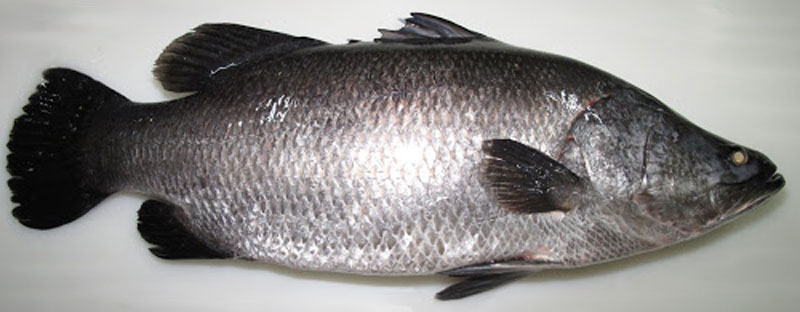
Download the mobile app!
Hooking Up Anglers Since 2011.
Check out our new Android or iOS app for Fishing Status.
The long awaited return of our mobie app is back on Apple App Store and Google Play
Barramundi
Species Information
| Scientific Name: | Lates calcarifer |
| Common Names: | Barramundi, asian seabass, koduva, ปลากะพง, పండుగొప్ప, kalaanji, bhetki, Chonak, ikan siakap, ikan kakap putih, apahap, pla kapong |
| Environment: | River, Inshore, Surf |
| Ideal Temp: | 77-86°F (25-30°C) |
About Barramundi
The Barramundi, also known as Asian seabass, is a species of catadromous fish in family Latidae of order Perciformes. This fish is of the same Genus as the Common Snook, which is found in the waters of Florida, Central and South America, the Caribbean and the South Atlantic. The native species is widely distributed in the Indo-West Pacific region from the Persian Gulf, through Southeast Asia to Papua New Guinea and Northern Australia. Known in Thai language as pla kapong (Thai: ปลากะพง), it is very popular in Thai cuisine. It is known as koduva in the Tamil language, kalaanji in Malayalam language, pandugappa (పండుగొప్ప) in the Telugu language in India, bhetki in the Bengali language in eastern India and Chonak in the Konkani language in Goa in western India.
This species has an elongated body form with a large, slightly oblique mouth and an upper jaw extending behind the eye. The lower edge of the preoperculum is serrated with a strong spine at its angle; the operculum has a small spine and a serrated flap above the origin of the lateral line. Its scales are ctenoid. In cross section, the fish is compressed and the dorsal head profile clearly concave. The single dorsal and ventral fins have spines and soft rays; the paired pectoral and pelvic fins have soft rays only; and the caudal fin has soft rays and is truncate and rounded. Barramundi are salt and freshwater sportfish, targeted by many. They have large, silver scales, which may become darker or lighter, depending on their environments. Their bodies can reach up to 1.8 m (5.91 ft) long, though evidence of them being caught at this size is scarce.
Barramundi are demersal, inhabiting coastal waters, estuaries, lagoons and rivers; they are found in clear to turbid water, usually within a temperature range of 26−30°C. This species does not undertake extensive migrations within or between river systems, which has presumably influenced establishment of genetically distinct stocks in Northern Australia.
The barramundi feeds on crustaceans, molluscs, and smaller fish (including its own species); juveniles feed on zooplankton. The barramundi is euryhaline, but stenothermal. It inhabits rivers and descends to estuaries and tidal flats to spawn. In areas remote from freshwater, purely marine populations may become established.
At the start of the monsoon, males migrate downriver to meet females, which lay very large numbers of eggs (several millions each). The adults do not guard the eggs or the fry, which require brackish water to develop.
The species is sequentially hermaphroditic, with most individuals maturing as males and becoming female after at least one spawning season; most of the larger specimens are therefore female. Fish held in captivity sometimes demonstrate features atypical of fish in the wild: they change sex at a smaller size, exhibit a higher proportion of protogyny and some males do not undergo sexual inversion.
Highly prized by anglers for their good fighting ability, barramundi are reputed to be good at avoiding fixed nets and are best caught on lines and with fishing lures. In Australia, the barramundi is used to stock freshwater reservoirs for recreational fishing.
These "impoundment barramundi", as they are known by anglers, have grown in popularity as a "catch and release" fish. Popular stocked barramundi impoundments include Lake Tinaroo near Cairns in the Atherton Tablelands, Peter Faust Dam near the Whitsundays, Teemburra Dam near Mackay, Lake Moondarra near Mount Isa, Lake Awoonga near Gladstone, and Lake Monduran south of Lake Awoonga.
Barramundi Fishing
| World Record: | 44.64 kg (98 lb 6 oz) Lake Monduran, Queensland, Australia 12-Dec-2010 |
| # Fish Caught: | 80876 documented in database. |
| Earliest Record: | 7/2/1790 12:00:00 PM and located at 27.00000, 51.00000. |
| Latest Record: | 4/4/2025 2:06:12 AM and located at -31.82141, 115.73853. |
| Common Techniques: | Casting, Fly |
| Popular Lure Types: | Crankbaits, Flies, Plugs, Soft Plastics, Spinnerbaits, Topwater |
| Fishing Spots: | 262 Barramundi fishing spots. |
Latest Barramundi Fishing Reports and Spots
96 Recfishwest's State-wide Fishing Report - 22 August 2025 All the best tips and photos on what's biting across WA including forecasts gear us (
View)
96 Recfishwest's State-wide Fishing Report - 15 August 2025 All the best tips and photos on what's biting across WA including forecasts gear us (
View)
96 Recfishwest's State-wide Fishing Report - 08 August 2025 All the best tips and photos on what's biting across WA including forecasts gear us (
View)
96 Recfishwest's State-wide Fishing Report - 01 August 2025 All the best tips and photos on what's biting across WA including forecasts gear us (
View)
96 Recfishwest Newsletter View this email in your browser Recfishwest Fishing Report 18/07/25 With decent weather expected across our northern (
View)
96 Recfishwest's State-wide Fishing Report - 25 July 2025 (new design!) All the best tips and photos on what's biting across WA including forec (
View)
96 Recfishwest Newsletter View this email in your browser Recfishwest Fishing Report 11/07/25 A great snap from Nigel Thompson of a trevally sc (
View)
96 Recfishwest Newsletter View this email in your browser Recfishwest Fishing Report 04/07/25 Another great snap of the metro mullet migration (
View)
96 Recfishwest Newsletter View this email in your browser Recfishwest Fishing Report 27/06/25 Some serious envy that @mat.kleczkowski.photograp (
View)
96 Recfishwest Newsletter View this email in your browser Recfishwest Fishing Report 20/06/25 Don't take this kind of life for granted if you l (
View)